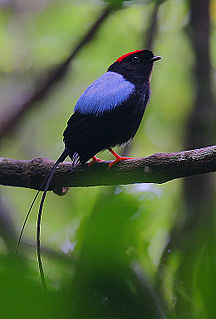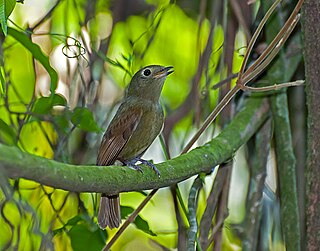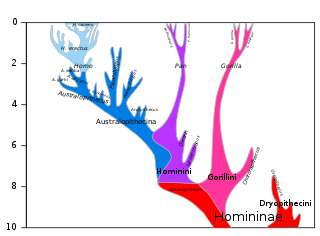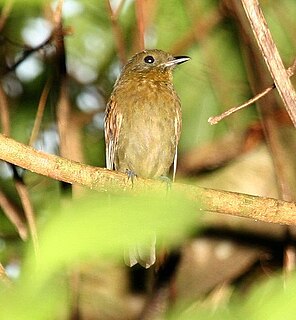Related Research Articles
Thrush may refer to:

Amazon parrot is the common name for a parrot of the genus Amazona. These are medium-sized parrots native to the New World ranging from South America to Mexico and the Caribbean.

The gadfly petrels or Pterodroma are a genus of about 35 species of petrels, part of the seabird order Procellariiformes. The gadfly petrels are named for their speedy weaving flight, as if evading gadflies (horseflies). The flight action is also reflected in the name Pterodroma, from Ancient Greek pteron, "wing" and dromos, "runner".

Prinia is a genus of small insectivorous birds belonging to the passerine bird family Cisticolidae. They were at one time classed in the Old World warbler family, Sylviidae.

The manakins are a family, Pipridae, of small suboscine passerine birds. The group contains some 60 species distributed through the American tropics. The name is from Middle Dutch mannekijn "little man".

Formicariidae is a family of smallish passerine birds of subtropical and tropical Central and South America known as formicariids. They are between 10 and 20 cm in length, and are related to the antbirds, Thamnophilidae, and gnateaters, Conopophagidae. This family contains probably some 12 species in two fairly small genera.

The yellow-crowned amazon or yellow-crowned parrot is a species of parrot native to tropical South America and Panama. The taxonomy is highly complex and the yellow-headed and yellow-naped amazon are sometimes considered subspecies of the yellow-crowned amazon. Except in the taxonomic section, the following deals only with the nominate group .They are found in the Amazon basin.

The Schwartz's antthrush, also known as the scalloped antthrush, is a species of bird in the Formicariidae family. It is found in humid highland forests in the Andes of Colombia and the Coastal Range in Venezuela. The Colombian population belongs to the nominate subspecies, while the Venezuelan belongs to chionogaster. Long included as a subspecies of the rufous-tailed antthrush, it was only recognized as a separate species in 1992. It takes its name from ornithologist Paul A. Schwartz, who was the first to realize how strikingly different its song sounds compared to that of the rufous-tailed antthrush. The song of Schwartz's antthrush is closer to that of the cryptic antthrush.

Drymodes is a genus of bird in the family Petroicidae. It was traditionally held to have two species, but molecular and behavioural differences led to the split of the New Guinea populations from the northern scrub robin. The paper by Les Christidis and colleagues was published in 2011 and the IOC adopted the split in 2015:
Mourner is the common name used for several Neotropical birds from families Tityridae and Tyrannidae.

The varzea schiffornis, also called várzea mourner or greater schiffornis, is a species of bird in the family Tityridae. It has traditionally been placed in the manakin family, but evidence strongly suggest it is better placed in Tityridae, where now placed by SACC.

The brown-winged schiffornis, is a species of Neotropical bird.

The greenish schiffornis, also greenish mourner or greenish manakin, is a species of bird in the family Tityridae. It has traditionally been placed in the manakin family, but evidence strongly suggest it is better placed in Tityridae, where now placed by SACC.

The plain-winged woodcreeper or thrush-like woodcreeper is a passerine bird belonging to the woodcreeper group, now classified in the ovenbird family, Furnariidae. It is sometimes considered to be a subspecies of the plain-brown woodcreeper.

Tityridae is family of suboscine passerine birds found in forest and woodland in the Neotropics. The 45 species in this family were formerly spread over the families Tyrannidae, Pipridae and Cotingidae. As yet, no widely accepted common name exists for the family, although tityras and allies and tityras, mourners and allies have been used. They are small to medium-sized birds. Under current classification, the family ranges in size from the buff-throated purpletuft, at 9.5 cm (3.7 in) and 10 grams, to the masked tityra, at up to 24 cm (9.5 in) and 88 grams. Most have relatively short tails and large heads.

The chimpanzee–human last common ancestor, or CHLCA, is the last common ancestor shared by the extant Homo (human) and Pan genera of Hominini. Due to complex hybrid speciation, it is not possible to give a precise estimate on the age of this ancestral population. While "original divergence" between populations may have occurred as early as 13 million years ago (Miocene), hybridization may have been ongoing until as recently as 4 million years ago (Pliocene).

The russet-winged schiffornis, is a species of Neotropical bird.
The foothill schiffornis, is a species of Neotropical bird.

The northern schiffornis, is a species of Neotropical bird.
The Guianan schiffornis or olivaceous schiffornis, is a species of Neotropical bird.
References
- ↑ Nyári, Á. S. 2007. "Phylogeographic patterns, molecular and vocal differentiation, and species limits in Schiffornis turdina (Aves)". Molecular Phylogenetics and Evolution 44: 154–164
| This page is an index of articles on animal species (or higher taxonomic groups) with the same common name (vernacular name). If an internal link led you here, you may wish to edit the linking article so that it links directly to the intended article. |